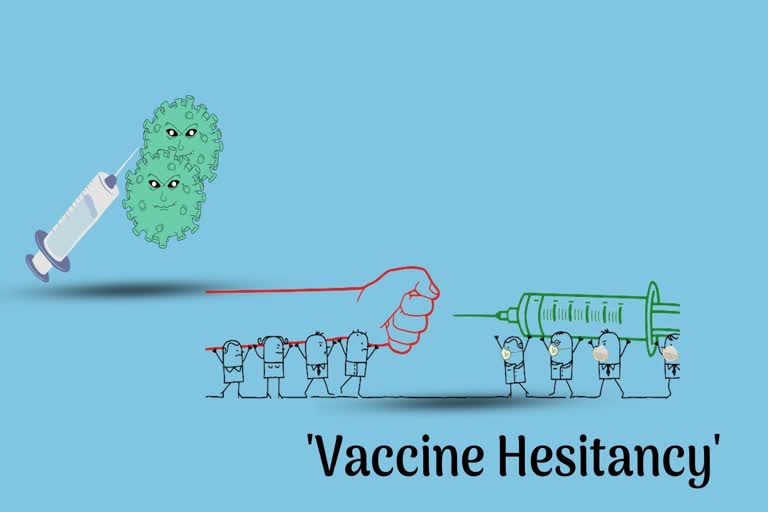The recent rollout of vaccines for COVID-19 across the world has brought some much-needed respite. The government of India has launched an ambitious COVID-19 vaccination drive on 16th January 2021, initially targeting frontline health care workers and later for persons above 50 years and below 50 years with co-morbidities. Vaccination campaign for the frontline workers has been reported for the most part to be successful, as about 33 lakh people across the country have been vaccinated within 14 days, faster than most of the countries including the USA, UK, and Israel. However, there is a lower turnout than anticipated leading to a stockpiling of vaccines. In addition, findings from various surveys across the different states indicate growing vaccine hesitancy during the past few months in health care workers, and the population at large, both in rural and urban areas. This is a stumbling block in the uptake of vaccines among the immediate target population and later for the larger population-based vaccination drive, leading to a delay in achieving herd immunity, which is critical to combat pandemics like COVID-19.
The Context For Vaccine Hesitancy:
Vaccines are recognized as an important scientific discovery that saved the world from many infectious diseases. World Health Organisation (WHO) describes vaccination as one of the most cost-effective public health measures that save 2.3 million lives a year. The project that a further 1.5 million lives per year can be saved if vaccine coverage can be increased across the world.
However, cynicism and distrust about vaccines have plagued vaccination efforts since the times of Edward Jenner, who developed a vaccine for smallpox disease in 1796. In recent times, vaccine hesitancy towards measles was reported in many countries especially the global north, leading to a resurgence of measles cases by 30% across the world. This led to WHO declaring vaccine hesitancy as one of the 10 threats to Global health. Historically, even in India vaccine hesitancy is not new and has been there to a varying extent for various vaccines, including for plague and cholera in the early 1900s and more recently to polio and HPV, etc. all for different reasons.
Vaccine hesitancy in simple terms is people refusing to take vaccines though they are available. Many studies and reports describe resistance to vaccination is based on primarily the belief that they cause more harm than any benefit and secondly, many communities opposing the mandatory immunization that is required to gain herd immunity and, in some instances, for religious and cultural beliefs about the manufacturing process.
How Do We Deal With VH:
Given the abundant scientific evidence that clearly establishes that vaccination protects an individual from disease and that when a majority gets vaccinated, it, in turn, contributes to herd immunity. This is an important message to the project, that vaccinating oneself is a social contract, an action to be taken to safeguard oneself and consequently the larger community. Conveying this message effectively requires a multi-pronged approach involving multiple stakeholders. Some of the important strategies that we can use are:
- First, ensure that getting vaccinated is easy, quick, and affordable, especially for the large proportion of the population who are not avoiding vaccination.
- Community engagement is critical for the successful uptake of vaccines and building vaccine confidence among the population through region/culture-specific campaigns focusing on both mass vaccination and precision vaccination. Interventions should be co-designed with the active participation of the community members.
- We need to allow for open and transparent dialogue and communication about the uncertainty and risks, but also about the safety and benefits of the vaccination at the community level.
- Rumors and misinformation contribute to vaccine hesitancy. It’s important to establish community-based rumor surveillance to counter them on a regular basis.
- Media has an important role to play in allaying the fears of the people. Media personnel has to be sensitized to capture the myths and misconceptions and debunk them proactively on a regular basis.
- Internet and social media have become important sources of information for a vast number of people. Social media platforms should work closely with public health experts to flag misinformation and also come up with inoculation messages to counter the infodemic.
- It’s important to develop trust amongst the people on vaccines. We need to harness social, regional, and political influencers, including trusted community figures, who should be at the forefront to motivate common people for vaccination.
- Primary health care should be sufficiently geared up to deal with adverse events following the vaccination
- Local innovations in service delivery may be encouraged to ensure vaccine coverage for the vulnerable and disadvantaged sections of the society.
- Managing expectations post-vaccination is also critical, as we have to continue to engage in protective measures (mask-wearing, physical distancing, etc), and this might also undermine vaccine acceptance and uptake efforts.
*The authors Dr. Nanda Kishore Kannuri, Dr. Gowri Iyer are faculty with the Indian Institute of Public Health, Hyderabad, Public Health Foundation of India Views are personal.



